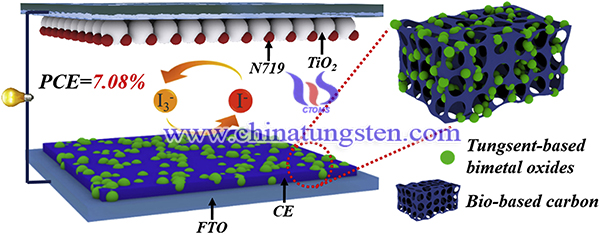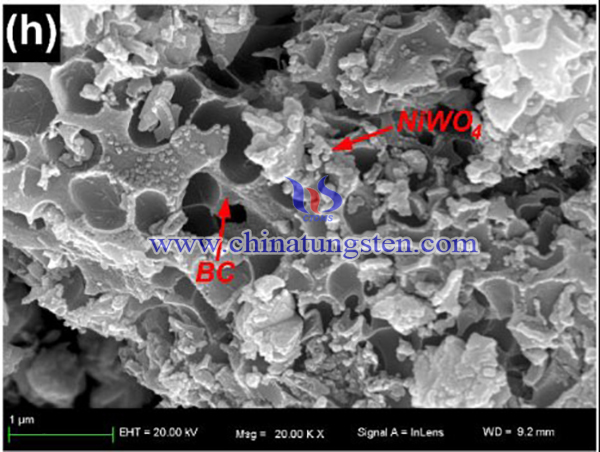Tungsten-Based Bimetal Oxides as Dsscs Electrodes Using APT as Tungsten Source
- Details
- Category: Tungsten Information
- Published on Wednesday, 03 February 2021 20:01
Dye-sensitized solar cells (DSSCs) have drawn wide attention because of their incomparable advantages including low cost, easy to manufacture, environmental-friendly and high theoretical photoelectric conversion efficiency (PCE). However, traditional Pt CE materials are expensive, have a limited source, and are easily corroded by the I3−/I− electrolyte.

Tungsten (W)-based compounds, have excellent catalytic properties owing to their electronic structures, which are similar to that of Pt. Thus, using waste biomass was used as a carbon source and ammonium paratungstate (APT) as tungsten source, tungsten-based bimetal oxides (NiWO4/BC ) were prepared through hydrothermal route and annealing. The DSSC fabricated with NiWO4/BC exhibited excellent PCE of 7.08%, which surpassed that of DSSC with Pt CE (6.46%).
The synthesis procedure of NiWO4/BC materials can be concluded as below:
Bio-carbon (BC) was derived from aloe peel waste. Aloe peels were washed with distilled water for the removal impurities and then dried at 105°C for 24 h. The dried aloe peels were crushed into powder with particle size ∼2 μm. 6 g aloe peel powder was added into 120 mL deionized water and vigorously stirred for 4 h. The obtained mixture was hydrothermally treated at 230°C for 15 h with a stainless-steel autoclave with Teflon lining. The sediment was washed with deionized water and alcohol for several times and then dried at 105°C for 24 h, resulting in hydrothermal carbon. 1 g hydrothermal carbon along with 2 g KOH was added into 20 mL deionized water and vigorously stirred for 4 h. The obtained mixture was dried at 105°C for 24 h, then subjected to activated treatment at 800°C for 2 h in N2 atmosphere. The activated product was washed with hydrochloric acid, alcohol, and deionized water successively until the filtrate was neutral, and dried at 105°C for 24 h, resulting in BC. Further details can be cited in our previous works.
MWO4/BC (M = Fe, Co, and Ni) were synthesized by hydrothermal treatment and annealing (Scheme 1). Fe(NO3)3·9H2O, Co(NO3)2·6H2O, and Ni(NO3)2·6H2O were used as metal (Fe, Co, and Ni) precursors, and ammonium paratungstate (APT) was used as a tungsten precursor. In detail, 5 mmol ammonium paratungstate and 20 mmol BC (the mole ratio of BC to MWO4 is 4, based on the previous literature [36]) were added into 50 mL deionized water and then vigorously stirred for 30 min. 5 mmol metal precursor was added, and the resulting solution was vigorously stirred for 4 h and then hydrothermally treated in an autoclave with Teflon lining at 220°C for 12 h. The obtained precipitate was washed with deionized water and alcohol repeatedly and then dried at 80°C for 48 h. Finally, the obtained powder was annealed at 500°C for 2 h in N2, resulting in MWO4/BC.

In summary, using waste biomass was used as a carbon source and ammonium paratungstate (APT) as tungsten source, a tungsten-based bimetal oxide was successfully prepared. In the hydrothermal system, BC worked as a structure-directing agent to direct the self-assembly of CoWO4 nanoflowers. reduction and fast electron transport capability owing to the synergistic effects of catalytic MWO4 and conductive BC. The developed NiWO4/BC composite CE can be a good alternative for traditional Pt electrode. The DSSC fabricated with NiWO4/BC exhibited excellent PCE of 7.08%, which surpassed that of DSSC with Pt CE (6.46%).
- APT Manufacturer & Supplier, Chinatungsten Online: ammonium-paratungstate.com
- Tungsten News & Prices of China Tungsten Industry Association: www.ctia.com.cn
- Molybdenum News & Price: news.molybdenum.com.cn
- Tel.: 86 592 5129696; Fax: 86 592 5129797; Email: sales@chinatungsten.com



 sales@chinatungsten.com
sales@chinatungsten.com